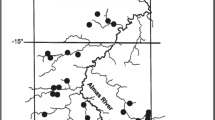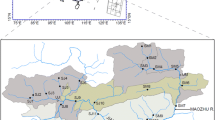Abstract
Tributary confluences play an important role in the dispersal of organisms, and consequently, in shaping regional scale diversity in stream networks. Despite their importance in dispersal processes, little is known about how ecological assemblages are organized in these habitats. We studied the scales of variability of stream fish assemblages over three seasons using a hierarchical sampling design, which incorporated three tributaries, three sites at the mouth of each tributary and using four sampling units at each site. We found strong scale dependent variability in species richness, composition and relative abundance. Most of the variation was accounted for by the interactive effect of season, between stream and between site effects, while habitat structure of the sampling units had a relatively minor role. Species richness showed a continuous decrease from the mainstem river in most cases, while species composition and relative abundance changed less consistently along the longitudinal profile. Consequently, we found that not only the junctions presented a strong filter on the species pool, but some species were filtered out if they passed this critical habitat bottleneck. In addition, spatial position of the tributaries along the river also contributed to assemblage variability in the confluences. Overall, our results suggest high variability in fish assemblages across multiple scales at tributary confluences. Environmental management should take a more critical care on the filtering role of tributary confluences in species dispersal, for better understanding patterns and processes in the branches of dendritic stream networks.





Similar content being viewed by others
References
Beckmann MC, Schöll F, Matthaei CD (2005) Effects of increased flow in the main stem of the River Rhine on the invertebrate communities of its tributaries. Freshw Biol 50:10–26
Benda L, Poff NL, Miller D, Dunne T, Reeves G, Pess G, Pollock M (2004) The network dynamics hypothesis: how channel networks structure riverine habitats. Bioscience 54:413–427
Dormann CF, Elith J, Bacher S, Buchmann C, Carl G, Carré G, García Marquéz JR, Gruber B, Lafourcade B, Leitão PJ, Münkemüller T, McClean C, Osborne PE, Reineking B, Schröder B, Skidmore AK, Zurell D, Lautenbach S (2013) Collinearity: a review of methods to deal with it and a simulation study evaluating their performance. Ecography 36(1):27–46
Erős T, Schmera D (2010) Spatio-temporal scaling of biodiversity and the species-time relationship in a stream fish assemblage. Freshw Biol 55:2391–2400
Erős T, Olden JD, Schick RS, Schmera D, Fortin M (2012) Characterizing connectivity relationships in freshwaters using patch-based graphs. Landscape Ecol 27:303–317
Fagan WF (2002) Connectivity, fragmentation, and extinction risk in dendritic metapopulations. Ecology 83:3243–3249
Gorman OT (1986) Assemblage organization of stream fishes: the effect of rivers on adventitious streams. Am Nat 128:611–616
Graham MH (2003) Confronting multicollinearity in ecological multiple regression. Ecology 84:2809–2815
Grant EHC, Lowe WH, Fagan WF (2007) Living in the branches: population dynamics and ecological processes in dendritic networks. Ecol Lett 10:165–175
Grenouillet G, Pont D, Seip KL (2004) Within-basin fish assemblage structure: the relative influence of habitat versus stream spatial position on local species richness. Can J Fish Aquat Sci 61:93–102
Grönroos M, Heino J (2012) Species richness at the guild level: effects of species pool and local environmental conditions on stream macroinvertebrate communities. J Anim Ecol 81:679–691
Heino J, Louhi P, Muotka T (2004) Identifying the scales of variability in stream macroinvertebrate abundance, functional composition and assemblage structure. Freshw Biol 49:1230–1239
Heino J, Grönroos M, Soininen J, Virtanen R, Muotka T (2012) Context dependency and metacommunity structuring in boreal headwater streams. Oikos 121:537–544
Hildrew AG, Giller PS (1994) Patchiness, species interactions and disturbance in the stream benthos. In: Giller AG, Hildrew AG, Rafaelli DG (eds) Aquatic ecology: scale, pattern and process, 34th symposium of the British Ecological Society. Blackwell, Oxford, pp 21–62
Hitt NP, Angermeier PL (2008) Evidence for fish dispersal from spatial analysis of network topology. J N Am Benthol Soc 27:304–320
Jackson DA, Peres-Neto PR, Olden JD (2001) What controls who is where in freshwater fish communities—the roles of biotic, abiotic and spatial factors. Can J Fish Aquat Sci 58:157–170
Kiffney PM, Greene CM, Hall JE, Davies JR (2006) Tributary streams create spatial discontinuities in habitat, biological productivity, and diversity in mainstem rivers. Can J Fish Aquat Sci 63:2518–2530
Legendre P, Legendre L (1998) Numerical ecology. 2nd English Edition. Elsevier Science, Amsterdam: BV. xv+853 p
Lepori F, Palm D, Brannas E, Malmqvist B (2005) Does restoration of structural heterogeneity in streams enhance fish and macroinvertebrate diversity? Ecol Appl 15:2060–2071
Ligeiro R, Melo AS, Callisto M (2010) Spatial scale and the diversity of macroinvertebrates in a Neotropical catchment. Freshw Biol 55:424–435
Matthews WJ (1998) Patterns in freshwater fish ecology. Chapman & Hall, New York
Milesi SV, Melo AS (2014) Conditional effects of aquatic insects of small tributaries on mainstream assemblages: position within the network matter. Can J Fish Aquat Sci 71:1–9
Morlon H, Chuyong G, Condit R, Hubbell S, Kenfack D, Thomas D, Valencia R, Green JL (2008) A general framework for the distance-decay of similarity in ecological communities. Ecol Lett 11:904–917
Muneepeerakul R, Bertuzzo E, Lynch HJ, Fagan WF, Rinaldo A, Rodriguez-Iturbe I (2008) Neutral metacommunity models predict fish diversity patterns in Mississippi–Missouri basin. Nature 453:220–222
Mykrä H, Heino J, Muotka T (2007) Scale related patterns in the spatial and environmental components of stream macroinvertebrate variation. Global Ecol Biogeogr 16:149–159
Oksanen J, Blanchet FB, Kindt R, Legendre P, Minchin PR, O’Hara RB, Simpson GL, Solymos P, Stevens MHH, Wagner H (2013) vegan: Community Ecology Package. R package version 2.0-10. http://CRAN.R-project.org/package=vegan
Osborne LL, Wiley MJ (1992) Influence of tributary spatial position on the structure of warmwater fish communities. Can J Fish Aquat Sci 49:671–681
Palmer MA, Menninger HM, Bernhardt E (2010) River restoration, habitat heterogeneity and biodiversity: a failure of theory or practice? Freshw Biol 55:205–222
Poff NL (1997) Landscape filters and species traits: towards mechanistic understanding and prediction in stream ecology. J N Am Benthol Soc 16:391–409
R Core Team (2013) R: a language and environment for statistical computing. R Foundation for Statistical Computing, Vienna, Austria. ISBN 3-900051-07-0. http://www.R-project.org
Rice SP, Greenwood MT, Joyce CB (2001) Tributaries, sediment sources, and the longitudinal organisation of macroinvertebrate fauna along river systems. Can J Fish Aquat Sci 58:824–840
Rice SP, Ferguson RI, Hoey TB (2006) Tributary control of physical heterogeneity and biological diversity at river confluences. Can J Fish Aquat Sci 63:2553–2566
Rice SP, Kiffney P, Greene C, Pess GR (2008) The ecological importance of tributaries and confluences. In: Rice SP, Roy AG, Rhoads BL (eds) River confluences, tributaries and the fluvial network. Wiley, New York, pp 209–242
Risser PG (1995) The status of the science examining ecotones. Bioscience 322:318–325
Roberts JH, Hitt NP (2010) Longitudinal structure of stream fish communities: evaluating conceptual models with temporal data. Am Fish S S 73:281–299
Thornbrugh DJ, Gido KB (2010) Influence of spatial positioning within stream networks on fish assemblage structure in the Kansas River basin, USA. Can J Fish Aquat Sci 67:143–156
Vellend M (2010) Conceptual synthesis in community ecology. Q Rev Biol 85(2):183–206
Ward JV, Wiens JA (2001) Ecotones of riverine ecosystems: role and typology, spatio-temporal dynamics, and river regulation. Ecohydrol Hydrobiol 1:25–36
Acknowledgments
We would like to express our thanks for the numerous people who helped in the field work including Zoltán Vitál, András Specziár, Árpád Ferincz, Gergely Erős, András Erős. This work was supported by the OTKA K104279 grant and the Bolyai János Research Scholarship of the Hungarian Academy of Sciences (Tibor Erős). The work of István Czeglédi was supported by the European Union and the State of Hungary, co-financed by the European Social Fund in the framework of TÁMOP 4.2.4. A/2-11-1-2012-0001 ‘National Excellence Program’.
Author information
Authors and Affiliations
Corresponding author
Electronic supplementary material
Below is the link to the electronic supplementary material.
27_2015_454_MOESM1_ESM.ppt
Distance decay relationships in fish assemblages at the habitat unit level (i.e. all units are compared within and between streams) for each season separately using the Jaccard and the Bray–Curtis dissimilarity indices for species composition and relative abundance data, respectively (PPT 415 kb)
Appendix
Appendix
See Table 7.
Rights and permissions
About this article
Cite this article
Czeglédi, I., Sály, P., Takács, P. et al. The scales of variability of stream fish assemblages at tributary confluences. Aquat Sci 78, 641–654 (2016). https://doi.org/10.1007/s00027-015-0454-z
Received:
Accepted:
Published:
Issue Date:
DOI: https://doi.org/10.1007/s00027-015-0454-z




